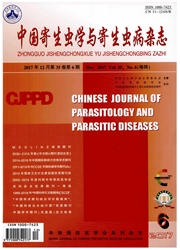

 中文摘要:
中文摘要:
目的观察田鼠巴贝虫(B06esio microti)隐性感染期小鼠经再感染、免疫抑制或盲传健康小鼠后的外周血红细胞内虫体密度的消长规律。方法取1只感染种鼠的外周血(虫密度为20%).腹腔接种6周龄雌性BALB/c健康小鼠12只,100μl/只,用随机数字表法分为对照组、再感染组、免疫抑制组和盲传组,每组3只。4组感染小鼠连续28d尾部采血。吉氏染色法观察田鼠巴贝虫形态变化。并计算红细胞染虫率,构建隐性感染小鼠模型.再感染组隐性感染小鼠再次腹腔接种相同剂量的田鼠巴贝虫感染种鼠血:免疫抑制组隐性感染小鼠腹腔注射地塞米松.0.5mg/只,连续注射5d:盲传组3只隐性感染小鼠取眼眶血,分别腹腔盲传接种健康雌性BALB/c小鼠各3只,100μJ/只。3组小鼠继续尾部采血28d,镜下计数感染红细胞,计算染虫率.并观察田鼠巴贝虫形态变化。结果对照组、再感染组、免疫抑制组和盲传组小鼠外周血均于感染后第3天查见田鼠巴贝虫体,第7天红细胞染虫率最高,分别为73.2%、78.0%、76.2%及79.0%,随后染虫率逐渐下降,至第28天外周血镜检阴性.进入隐性感染阶段。再感染组小鼠再次感染后28d内,每天染虫率均为0。免疫抑制组小鼠在免疫抑制后第2天查见虫体.第12天染虫率再次达到高峰。为65.2%,随后逐渐下降,至第22天再次进入隐性感染期。盲传组新感染的9只小鼠在感染后第4天查见虫体,第9~10天染虫率达到高峰,为35.0%--39.0%,随后逐渐下降.至第28天小鼠进入隐性感染阶段。各组感染的田鼠巴贝虫形态变化基本一致.染虫初期以小环状体居多:染虫高峰期多见大环状体和长丝状体:有多虫寄生现象。结论田鼠巴贝虫隐性感染期小鼠有带虫免疫现象,并可作为传染源;经免疫抑制后虫体被激化,可出现与首次感染?
 英文摘要:
英文摘要:
Objective To observe the infection dynamics of Babesia microti in mice with latent infection af- ter re-infection, immunosuppression, or random transmission to healthy mice. Methods Twelve healthy BALB/c mice at the age of six weeks were intraperitoneally (i.p.) injected with 100 μl peripheral blood collected from in- fected mice (B. microti density, 20%) and then divided into 4 groups (control group, re-infection group, immunosup- pression group and random transmission group, n = 3 in each). Tail blood collection was performed for 28 consecu- tive days to observe morphological changes of B. microti using Giemsa staining, calculate red blood cell (RBC) in- fection rate, and establish the mouse model of B. microti latent infection. Then the re-infection group once again re- ceived an i.p. injection of infected blood at the same dose as above and the immunosuppressive group received i.p.injection of dexamethasone (an immunosuppressant) for five consecutive days(0.5 mg/day). Orbital blood samples were collected in the random transmission group, which were then i.p. injected into 9 healthy BALB/c mice (1 : 3). Tail blood was collected from the 3 groups of mice for consecutive 28 days to calculate RBC infection rate with mi- croscopy and observe morphological changes of B. microti. Results B. microti parasites were first seen in RBC on day 3 in all the 4 groups. The RBC infection rate peaked on day 7(73.2%, 78.0%, 76.2% and 79.0% in control, re-infection, immunosuppression and random transmission groups, respectively), and gradually declined thereafter till the negative infection under a microscope, suggesting a latent infection phase. In the re-infection group, the rate of re-infection was 0 throughout the 28 days, while in the immune suppression group, re-infection was detected from day 2, reached a peak on day 12 (65.2%), and declined thereafter till 0 on day 22 (a latent infection phase). B. microti were firstly seen on day 4 in the transmitted nine mice, reached a peak o
 同期刊论文项目
同期刊论文项目
 同项目期刊论文
同项目期刊论文
 期刊信息
期刊信息
